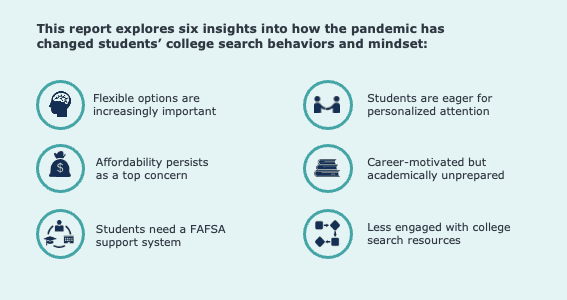Master these 6 trends to recruit and retain ‘Gen P’ at your community college
As a former community college admissions director, I spent countless hours sitting around tables with my colleagues trying to figure out what prospective students wanted from us. At EAB, we grapple with the same challenges, especially amidst declining enrollment rates and wavering public confidence in higher education. To secure future enrollment and rebuild confidence, it’s critical to understand the preferences of incoming students and ensure college experiences match expectations—particularly among ‘Gen P,’ students whose college-going behavior was shaped by the pandemic.
In this blog, we’ll explore six trends unique to community college prospects. Understanding these trends will help you better recruit and retain ‘Gen P.’
About the research
EAB conducted a survey in spring 2023, engaging over 20,000 high school students. Among them, 2,700 expressed potential interest in attending community college. Notably, these students exhibited distinct drivers and search habits compared to their counterparts pursuing four-year colleges. Our team compared three types of students: 1) those only considering two-year colleges, 2) those only considering four-year colleges, and 3) those considering both.
| Respondent Type | N= |
|---|---|
| Considering Two-Year Only | 418 |
| Considering Two-Year and Four-Year | 2,320 |
| Considering Four-Year Only | 13,643 |
We’ve analyzed the results in our new insight paper, “Supporting ‘Gen P’: Understanding the Next Generation of Community College Learners” and uncovered six trends that are unique to students who are considering two-year colleges.

Trend #1: Flexible options are increasingly important
Gone are the days when online and hybrid learning were things that only attracted working adults. Prospective community college students expressed significant interest in online and hybrid formats, ranking “flexible options” as one of their top value drivers. Notably, those exclusively interested in two-year colleges placed even greater value on these formats compared to their four-year college peers.
| Respondent | Two-Year Only | Two-Year and Four Year | Four Year Only |
|---|---|---|---|
| Want most or all of their courses online | 14% | 7% | 3% |
| When asked what they are looking for in a college experience, ranked “flexible scheduling (e.g., part-time, online, night classes) as a top three consideration | 30% | 20% | 10% |
This trend aligns with the recent surge in online enrollment at community colleges. As more Gen P students enter college, community colleges must ensure student services are accessible and remotely available, from inquiry to graduation.
Trend #2: Students are eager for personalized attention
While students expressed interest in online and hybrid formats, that interest does not diminish their desire for personal connections with their colleges. When seeking the best value for their education, two-year prospects are more likely than their four-year counterparts to prioritize small classes—an encouraging trend given community college classes are typically smaller size.

Additionally, students were asked what types of recruitment events they prefer, ranging from large events with hundreds of attendees to virtual-only events. Community college prospects were more likely to gravitate to smaller recruitment events that were close to home, as opposed to larger gatherings. This desire for a more intimate setting might reflect that students want to be able to ask questions directly to admissions teams.
Lastly, our survey revealed that compared to their four-year-aspiring peers, community college prospects were less likely to leverage family, friends, and classmates during their college search process—potentially leaving “college knowledge” gaps that institutions need to help close. We know this can put larger demands on admissions and enrollment teams, and potentially lead to students falling through the cracks. This underscores the importance of addressing potential “college knowledge” gaps through timely responses to student inquiries and tailored communications.
HOW TO CLOSE CUSTOMER SERVICE GAPS THAT CAN LEAVE STUDENTS FEELING DISCONNECTED
Trend #3: Affordability persists as a top concern
Even though community colleges are arguably one of the most cost-effective higher education options, with many students experiencing no out-of-pocket tuition costs after financial aid, that doesn’t mean that students perceive education to be affordable. Many young adults are being raised by parents who have crushing student loan debt, so it’s easy to understand why teenagers may be increasingly cost-conscious when researching colleges.
Our research indicates that 52% of students considering a community college were specifically doing so to manage their college costs. Additionally, two-year aspiring students were 15% more likely to prioritize affordable tuition as a top asset in their college experience.

Students, and the general public, have been thinking more critically about the “value” of higher education from an investment standpoint. Community college prospects are coming from homes with modest to middle incomes (70% of respondents had household incomes under $90k), so it makes sense that scholarships and aid would weigh heavily in students’ college search process. What’s striking is that community college students were 7% more likely to cite scholarships as a value driver, and 6% more likely to cite aid packages compared to students not considering two-year options. This signals that these students are not only looking at sticker price—they are also looking for creative ways to lessen the burden of college costs.

To provide students with clear information on financial aid, scholarships, and partnerships that can reduce college costs, different areas of the college need to work collaboratively to create financial opportunities for learners.
BREAK DOWN SILOS BETWEEN FINANCIAL AID, ADVISING, AND FACULTY
Trend #4: Students need a FAFSA support system
As students become more cost-conscious, encouraging them to complete the FAFSA is crucial in addressing their cost concerns. Community college prospects are half as likely as four-year prospects to report that a college representative encouraged them to complete their FAFSA. This may suggest a need for greater proactivity in providing support and guidance from two-year colleges or less engagement from students with college representatives.
We know that younger students need a support system when completing their FAFSA because information from their immediate family is needed to complete the process. Community college prospects were less likely to report that their parents encouraged them to complete their FAFSA and helped them to complete it. In fact, students only considering community colleges were 16% less likely than their four-year-aspiring peers to receive FAFSA help from their parents, and almost twice as likely to receive help from high school counselors.
Who helped you to complete the FAFSA?
| Respondent | Two-Year Only | Two-Year and Four Year | Four Year Only |
|---|---|---|---|
| Parents/Guardians | 67% | 71% | 83% |
| School counselors | 33% | 29% | 18% |
A positive note is that 85% of prospective community college students had completed their FAFSA spring of their senior year; but completing the FAFSA is only the first step in the financial aid journey. Some students will be selected for verification, and without a strong family support system navigating the verification process—which often requires documents from family members—can feel impossible. Community colleges need to act as financial aid partners with students to help fill in the support gaps that prospective students may face.
Trend #5: Career motivated, but academically unprepared
There is a noticeable shift in public focus toward the return on investment (ROI) of a college education. Students considering community colleges are no exception, with 72% intending to earn a bachelor’s degree and viewing community college as a pathway to that goal. These students placed a higher value on a college’s career services options compared to their four-year-aspiring peers.

This is good news for community colleges, who historically place strong emphasis on career preparation, career alignment, and working alongside employers. This trend might also point to students who need assistance finding jobs while they are working on their program, not just when they are ready to graduate.
While these students are career and transfer oriented, they also show concerns about their future success in college, including their academic readiness. When asked why they were considering a community college, 44% said it was to prepare academically for a four-year college. And when asked about what makes them most nervous about college, prospective two-year students were more likely to cite their ability to be successful. This highlights a need for community colleges to emphasize supports like career services, tutoring, and mentoring that can help students feel like their career goals are achievable while also building their academic confidence.
HOW BROWARD COLLEGE USES NAVIGATE360 TO SUPPORT EARLY ACADEMIC INTERVENTIONS
Adam Derosa, Associate Dean, Student Services, Broward College
Trend #6: Less engaged college search behaviors
One of the strengths of community colleges is the open access commitment that allows students to apply and register on very flexible timelines—sometimes right before the semester starts. Anyone who has worked at a community college can relate to the wave of applications that pour in from high school seniors when they are in their last semester, or even over the summer. Our data confirms that students who are only considering two-year colleges start their college search process much later than their peers. Over 25% of these students didn’t start their college search process until their senior year.
Interestingly, students who are open to both community and four-year colleges reported starting their college search earlier, representing a significant opportunity to build early connections with prospects. By fall of their junior year, more than 70% of students considering either option had started their search, compared to 49% of students only considering community colleges. Students who are considering four-year colleges are also more likely to apply to more colleges than students only considering community colleges.

-
Tip
Enrollment professionals should examine the middle group, who are considering either option, very closely when thinking about how and when to target messaging. These students, who could choose either path, are engaging in college search behaviors earlier and could be applying to 8 or more institutions. To compete for this “moveable middle,” community colleges need to build earlier connections and create a value proposition that rivals four-year competitors.
Summary
To meet the needs of ‘Gen P,’ community colleges must focus on personalization, proactive communication, and developing coordinated care networks that include financial aid, career services, advising, and faculty. Using technology like Navigate360 equips your teams to take on these challenges in a streamlined and collaborative way.
Ready to get started with Navigate360?
To speak with an expert or request a demo, please submit this form.

More Blogs

4 lessons about the “make-or-break year”

Four ways community colleges can improve career readiness
